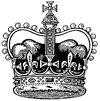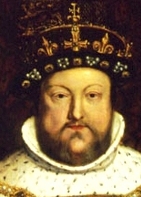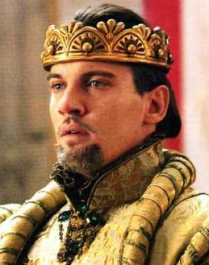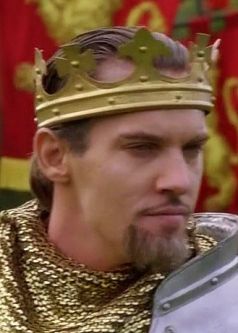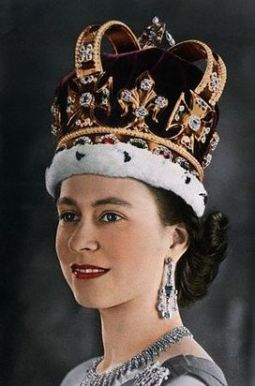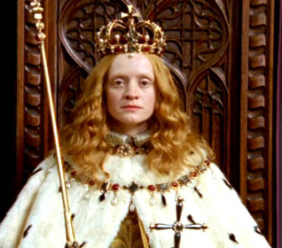CROWNS on the Tudors
Jump to navigation
Jump to search
[source: Coronet images from University of Notre Dame's <a class="external" href="http://www.rarebooks.nd.edu/digital/heraldry/charges/crowns.html" rel="nofollow" target="_blank">Heraldic Dictionary</a>]
Royal Crowns from "The Tudors"Uneasy Lies the head that wears the Crown [Shakespeare] *please don't post pics already on The Ladies Tiaras page here & one pic per crown Click EasyEdit to add to this page! (Don't see the EasyEdit button above? <a href="../#signin" target="_self">Sign in</a> or <a href="../accountnew" target="_self">Sign up</a>.) See also : Court Titles and offices More British Royal Crowns |
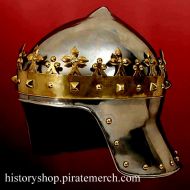 Around a millennium back, English kings were invested with a helmet set on an ornamental frame, that is the crown that we associate with the royalty. Historians attribute evidence of this to the seal of Edward the Confessor, wherein he wears a helmet with an ornamental frame. Another version of crown in early days in England and in other countries reportedly consisted of a string of jewels, which was tied at the back with a ribbon or set in a stiff golden band. However, the nobility too adapted this helmet and there arose a need for a headdress that would distinctly single out the sovereign. The king’s helmet was embellished with a number of ornaments that stood up from the rim. During the 15th century, the headdress was further embellished by adding a few arches that rose from the centre. Similar reproduction helmet NB. Henry always wore a hat like all men & women in Tudor times. There are no pictures of him in a crown as shown on the series. |
| King/Queen | Duke/Duchess | Marquess/Marchioness |
| Earl/Countess | Viscount/Viscountess | Baron/Baroness |
| The King |
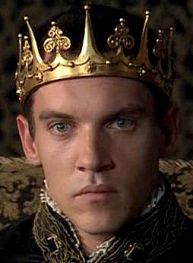 Season 1 This coronet has the 8 strawberry leaves and 8 pearls of an earl's crown not a king's crown | 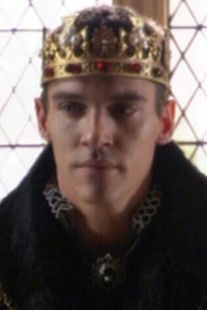 Season 1 |
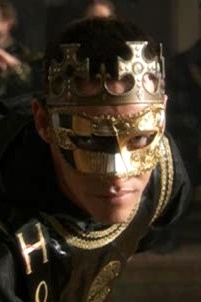 Season 1 | 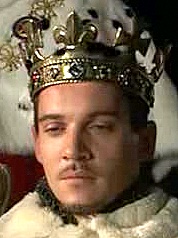 Season 2 features the fleur de lis & cross similar to the picture of the real Henry above Catherine Parr |
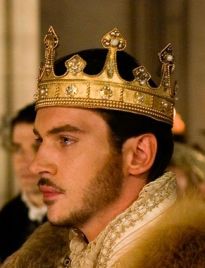 Same crown was used in Season 2 for Anne Boleyn's coronation and Season 3 for Henry's wedding to Jane Seymour | |
| The Queen Consorts Unlike reigning Monarchs who may inherit one or more crowns for use, Consorts sometimes had special crowns made uniquely for them. These crowns were usually not worn by later Consorts, but in the case of The Tudors, they were reused. |
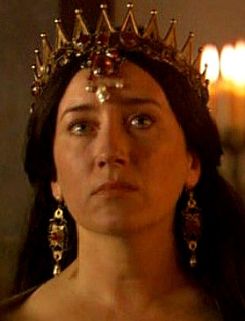 Queen Katherine of Aragon | 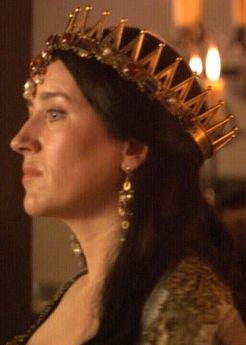 |
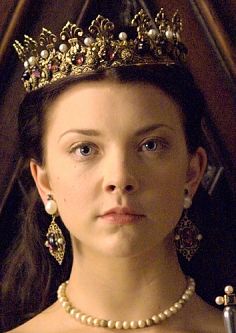 Coronation of Queen Anne Boleyn | 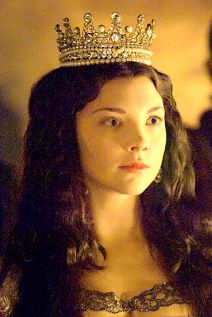 Anne and Henry's Wedding (same crown as Jane below, only modified) |
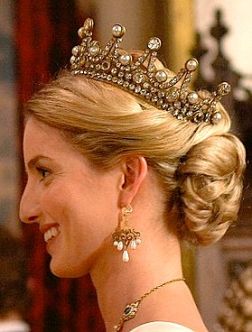 Queen Jane Seymour | 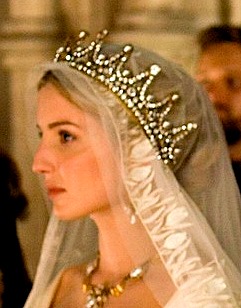 Jane and Henry's Wedding This could be a modified version of Anne Boleyn's crown above. Jane was never seen in the series wearing a 'crown'. If it is the same, they removed the bottom diamond and pearl rows, leaving the tiara with only one row of diamonds at the base. *Because it is not a complete circle or circlet it is not a crown, it is a tiara. |
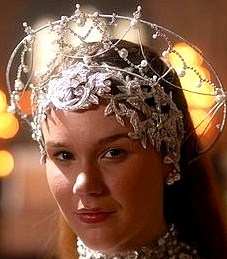 wedding * Note: This is a headdress not a crown which is a circlet of precious metals & gems Queen Anne of Cleves | |
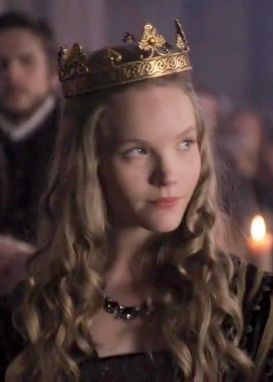 Queen Katherine Howard | 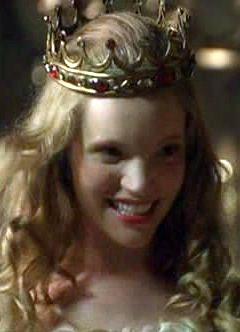 |
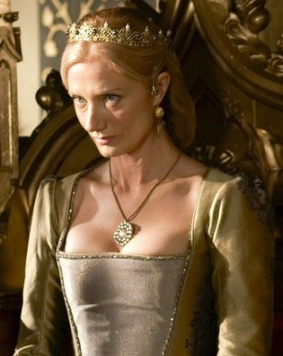 Queen Catherine Parr | 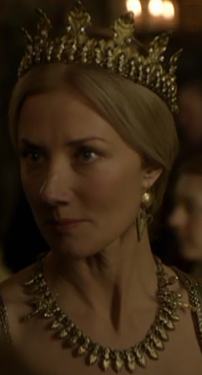 |
| The Royal Heirs (Prince, Princess, Duke) |
| <img align="bottom" alt="Henry Fitzroy's crown" height="185" src="http://image.wikifoundry.com/image/1/GWy4QjboNgTRjpqFYXZD7w8851/GW143H185" title="Henry Fitzroy's crown" width="143"/> Henry Fitzroy, 1st Duke of Richmond, Duke of Somerset, Earl of Nottingham, son of Elizabeth Blount & King Henry VIII | 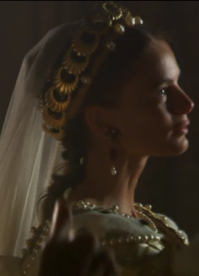 Princess Margaret at her wedding in Portugal. | 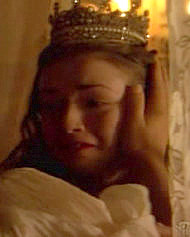 Princess Mary Tudor (in a crown in her mother's dying dream) |
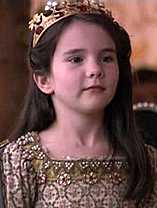 Young Princess Mary Tudor | ||
| Other Nobility |
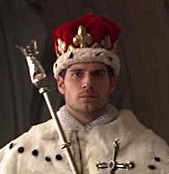 Charles Brandon, 1st Duke of Suffolk | 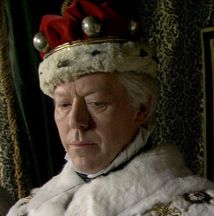 Sir Thomas Boleyn, Earl of Wiltshire |
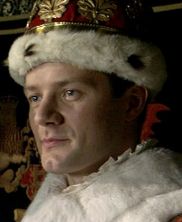 George Boleyn, Earl of Rochford | 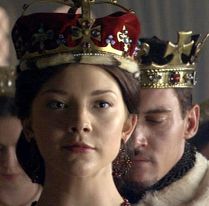 Anne Boleyn's investiture as Marquess of Pembroke |
 British Royal Crowns |
| <embed height="282" src="http://widget.wetpaintserv.us/wiki/thetudorswiki/widget/youtubevideo/e2e34cc3d186d8dd20be4186940c150f25b3f88d" type="application/x-shockwave-flash" width="344" wmode="transparent"/><embed height="282" src="http://widget.wetpaintserv.us/wiki/thetudorswiki/widget/youtubevideo/1539a11503812d47cfa9d5a9535a9c45bb35fa98" type="application/x-shockwave-flash" width="344" wmode="transparent"/> |
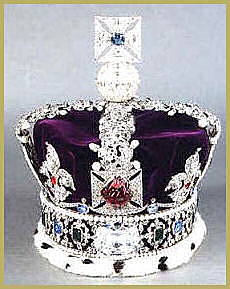 The Imperial State Crown The Imperial State Crown was made in 1937 for King George VI, and was similar to the diamond crown made in 1838 for Queen Victoria. The present Crown is made of gold and includes four crosses pattée and four fleurs-de-lis, with two arches on top, surmounted by a cross pattée. The Crown includes many jewels: 2,868 diamonds, 273 pearls, 17 sapphires, 11 emeralds, and five rubies. Among the stones are several famous ones, including the Black Prince's Ruby (actually a spinel) and the Cullinan II diamond, also known as the Lesser Star of Africa. Two of the three pearls dangling from the crown were once worn by Queen Elizabeth I. It is worn after the conclusion of the Coronation ceremony when the monarch leaves Westminster Abbey and also at the annual State Opening of Parliament. 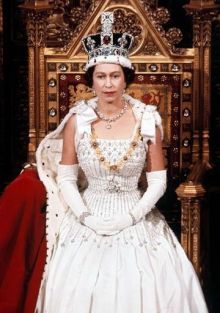 The Black Prince's Ruby weighs roughly 170carats (34g) and is approximately the size of a chicken egg. 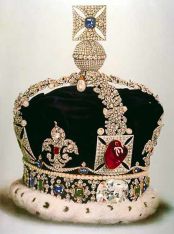 The Black Prince's Ruby is one of the oldest of the Crown Jewels of the United Kingdom, with a known history dating back to the middle of the 14th century and having been in the possession of the British kings since it was given in 1367 to its namesake, Edward of Woodstock (the "Black Prince"). | St. Edwards Crown The original crown of St. Edward the Confessor (from whom the present crown takes its name) was worn by him at Christmas 1065. This may itself have incorporated material from a crown of Alfred the Great. Anne Boleyn is the only consort, before or since, to have been crowned with the St Edward crown, which is reserved for the actual monarch. 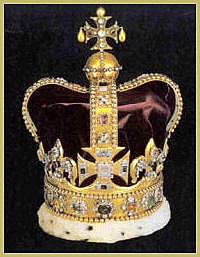 The original of the present St. Edward's Crown was made in 1661. It was replaced after Cromwell demolished of it. Made of gold, its design consists of four crosses pattée and four fleurs-de-lis, with two arches on top. Surmounting the arches is a jeweled cross pattée. The Crown includes 444 precious stones. 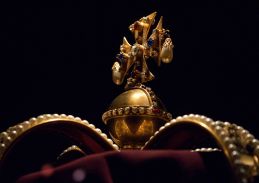 It is used through most of the coronation ceremony and is said to be made of the melted gold from King Alfred's Crown. It is noted by a number of British monarchs to be extremely heavy and difficult to wear. Queen Victoria was crowned with the lighter State Crown and even Queen Elizabeth II opted to use a stylised representation of this crown in images of the Royal Coat of Arms of the United Kingdom. | 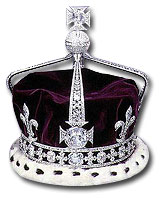 Queen Elizabeth, The Queen Mother's Coronation Crown The Crown of the Queen Mother is the platinum crown manufactured for, and worn by, Lady Elizabeth Bowes-Lyon, the queen consort of King George VI of the United Kingdom at their coronation in Westminster Abbey in 1937. It is the first crown for a British consort to be made of platinum. The crown was made by Garrard & Co in London, the longterm manufacturer of British royal crowns, and modelled partially on the design of the Crown of Queen Mary, the crown of Mary of Teck, wife of King George V. It consists of four half-arches, in contrast to the eight half-arches of Queen Mary's crown and ten half-arches of the Crown of Mary of Modena. As with Queen Mary's crown, its arches were detachable at the cross-pattee, allowing Elizabeth to wear the crown as a circlet. The crown is decorated with precious stones, most notably the 105-carat (21g) Koh-i-Noor Diamond in the middle of the front cross. The Koh-i-Noor remains in the crown to this day, as does the 17 carat diamond which was given to Queen Victoria in 1856 by the Sultan of Turkey. It is set directly below the Koh-i-Noor on the front band. The crown contains 2800 diamonds. "The Curse of The Koh-i-Noor"; a long and blood thirsty history since it was first recorded in 1304. It was then the property of Sultan Allah ed Din. Over centuries of murder, brutality and torchure, not to mention deceit – the stone had carried a curse – that misfortune would always befall the owner, although any woman wearing it would remain unharmed. After the death of her husband, Queen Elizabeth (known thereafter as Queen Elizabeth the Queen Mother) ceased to wear the full crown, but wore it minus the arches as a circlet at the coronation of her daughter, Queen Elizabeth II in 1953. The crown, with full arches attached, was placed on the coffin of the Queen Mother during her funeral in 2002. The crown is now on display with the diamond in the Jewel House in the Tower of London. 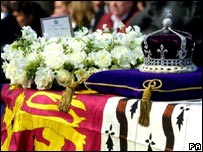 |
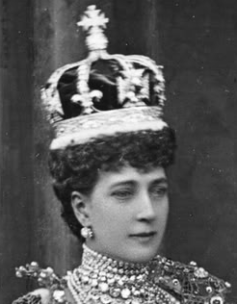 The Coronation Crown of Queen Alexandra The consort crown of Princess Alexandra of Denmark, the queen consort of King Edward VII of the United Kingdom. It was manufactured for the 1902 coronation. Queen Victoria's death in January 1901 brought to an end a gap of sixty-four years when the United Kingdom had been without a crowned queen consort, since Prince Albert of Saxe-Coburg and Gotha had not been crowned as a consort. Traditionally queens consort were crowned with the Crown of Mary of Modena. However in 1831, Adelaide of Saxe-Meiningen, consort of King William IV of the United Kingdom, was crowned with a 4 half-arched new small crown, the Crown of Queen Adelaide, because the Modena crown was judged too poor in quality, too old and too theatrical. In 1902 it was decided to use neither the Modena nor Adelaide crowns for the first coronation of a queen consort in seven decades. Instead it was decided to create a brand new consort crown, to be named after Queen Alexandra. The crown itself departed from the standard style of British crowns, and was more akin to European royal crowns. It was less upright than the norm in British crowns, and more squat in design, with an unpredecented eight half-arches. Its front arch joined a jewelled cross into which was set the Koh-i-Noor diamond. As with the later Crown of Queen Mary and Crown of Queen Elizabeth, the arches were detachable, allowing the crown to be worn as a circlet. The Crown of Queen Alexandra was not worn by later queens, with new crowns being created for Mary of Teck in 1911 and Elizabeth Bowes-Lyon in 1937. The major stones have been replaced with artificial ones referred to as paste. | 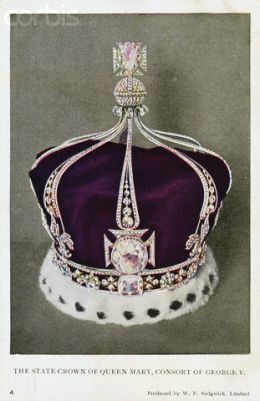 Queen Mary's Crown Queen Mary’s Crown is set entirely with diamonds and crystals was made for Queen Mary when she was crowned Queen Consort with George V in 1911. Queen Mary’s crown originally contained the 3d Star of Africa in the cross pattee which surmounts the heavily jewelled monde and the 4th Star of Africa in the band. Both these diamonds were cut from the Cullinan I diamond, which is the biggest diamond in the world. Both these diamonds are the personal property of Queen Elizabeth II and are not part of the Crown Jewels. They are known as the Lesser stones of Africa and were mounted in such a way that they can be removed and worn separately as a pendant or brooch. These stones were replaced by replica crystal stones. The crown contains eight half arches. Unlike any other coronation crowns, it was specially constructed, so that its arches could be removed, allowing for the crown to be worn as a circlet.The crown was regarded as a miracle of construction because it weighed less than 22.85 oz..when mounted with around 2200 diamonds. Queen Mary used the crown in circlet form at the coronation of George VI and at State Ceremonies involving her granddaughter Queen Elizabeth II. The crown was regarded as a miracle of construction because it weighed less than 22.85 oz..when mounted with around 2200 diamonds. Since Queen Mary’s death on 24th March 1953 her consort crown has remained unworn. | 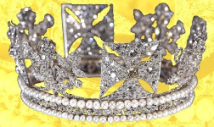 King George IV State Diadem This beautiful jewel is made of diamonds and pearls. The circular diadem is decorated with four crosses-pattées, set with diamonds, representing St. George, the front one with a wonderful honey-coloured diamond in the centre. Set with 1,333 diamonds, weighing 327.75 carats. It includes a four-carat pale yellow brilliant in the centre of the front cross and 169 pearls along the base. The four bouquets of flowers in diamonds include roses, thistles and shamrocks, representing England, Scotland and Ireland. Wales, being a principality, was not represented. The Diadem was made in 1820 for the coronation of George IV. It was constructed to encircle the velvet “Cap of Estate” that he wore in the procession to Westminster Abbey. The diadem has been regularly worn (and slightly modified) by queens regnant and consort from Queen Adelaide onwards. This feminine association belies its origin, since it was made for George IV's use at his famously extravagant coronation in 1821. In 1902, for Alexandra's coronation procession, the diamond scrollwork band was remounted and was framed between two rown of pearls. The diadem was also worn during the coronation procession of Queen Victoria and later Queen Elizabeth II. 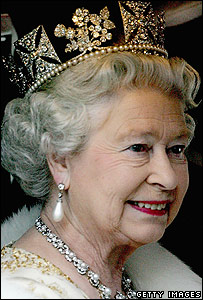 |
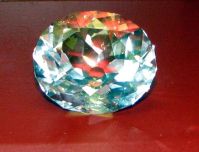 The legendary Koh-i-noor, or Mountain of Light diamond. Indian in origin, its history can be traced to the thirteenth century. It was presented to Queen Victoria by the East India Company in 1850. A legend clings to it that it brings good luck to any woman that wears it, but disaster to any man and many of the men that have owned it have met a violent end. | 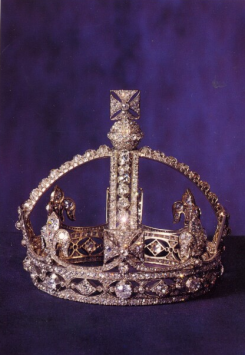 Queen Victoria’s Diamond Crown Ordered by Queen Victoria for her personal use. She found the Imperial State Crown too heavy, and very much resented the complicated procedures involved when removing the crown from the Tower of London. The small crown is a beautiful crown of heraldic Tudor form, which was made from Queen Victoria’s own expense in 1870.It was the crown perhaps most associated with Queen Victoria .Such was the association that the crown was placed on her coffin before her funeral. Origins:Following the death of her husband, Prince Albert, Queen Victoria withdrew from public life and wore the widows weeds which she continued to wear until her death in 1901. By government pressure she came back to public life in 1870.Queen Victoria refused to wear the Imperial State Crown partly because it was too heavy and also because it was impossible to wear her mourning veil.The new small crown was created as a replacement.Because of its size it could be worn on top of her mourning veil, so meeting the ceremonial needs of the British monarchy and her own desired form of dress as a widow.It is made up of four half arches which are met at a monde, on which sits a cross.Each half arch runs from the monde down to a cross pattee along the band at the bottom.Between each cross patee is a fleur-de-lis.The crown does not have an internal cap. Jewels:The crown is made of silver.It contains 1187 diamonds which were permitted to be worn in mourning unlike coloured stones.The diamonds all came from a necklace owned by Queen Victoria.After Victoria:Technically the crown belonged to Queen Victoria personally rather than the British Crown, and therefore did not form part of the British Crown Jewels.In her will Queen Victoria left it to the British Crown.In 1937 King George VI ordered that it should be moved from Windsor Castle and added to the regalia kept in The Tower of London where it remains on show to this day. | 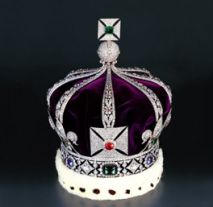 Imperial Crown Of India The Imperial Crown of India was made for King George V to wear at the Delhi Durbar in 1911, when he was acclaimed Emperor of India. The Imperial State Crown cannot be taken out of England. The Imperial Crown of India will probably never be worn again and its significance is now purely historical. The crown has eight half arches which spring from the cross pattee and fleur-de-lis, and it contains a remarkably fine emerald, a number of other emeralds, sapphires, rubies and over 6000 diamonds which were sent over from India. The Imperial Crown of India is housed but not part of the British Crown Jewels. King George and Queen Mary travelled to Delhi for the Durbar service proclaiming them Emperor and Empress of India to the princess of India. The King was not crowned at the service because the Archbishop of Canterbury did not think it suitable for a Christian religious service to take place in a predominantly Hindu country. Therefore, the King wore the crown when he entered the arena where the Durbar took place. The crown has not been worn by any sovereign since. Weight 34.05 oz. The King complained that the weight of the crown hurt his head. |
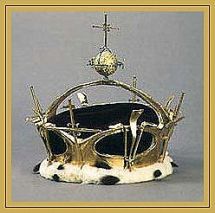 The Prince of Wales crown, made for the 1969 investiture of Prince Charles.A new crown which was made for the occasion. Made by a technique of applying gold to a resin base, it has four crosses and four fleur de lis, in keeping with the design issued by a warrant of Charles II in 1672. | 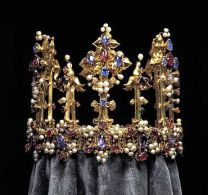 Crown of an English Queen (the "Bohemian" or "Palatine" crown; gold, enamel, apphires, rubies, emeralds, diamonds, pearls; height 18 cm, diam. 18 cm), western Europe, around 1370-80 The crown is recorded in England in a list of jewels and plate drawn up in 1399. It probably belonged to King Edward III or Anne of Bohemia, the wife of King Richard II, who was deposed that year by Henry IV. Henry's daughter, Princess Blanche, married the Palatine Elector Ludwig III in 1402 and the crown passed to the Palatine Treasury in Heidelberg as part of her dowry. In 1782 it was transferred to the Munich Treasury along with other jewels belonging to the Palatine branch of the Wittelsbach family. This is the oldest surviving crown of England. | |
| LINKS:
| LITERATURE: |
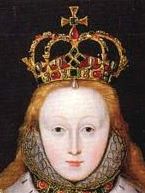 Crowns from other Movie & TV depictions of Royalty |
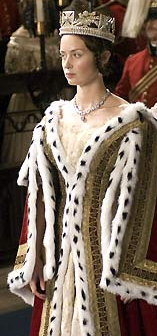 | 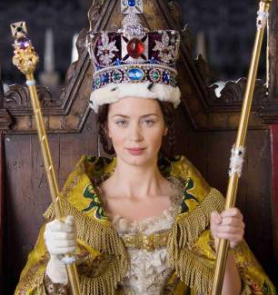 The Young Victoria (2008) 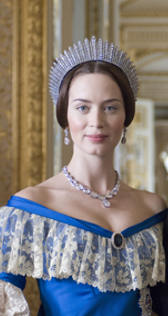 | 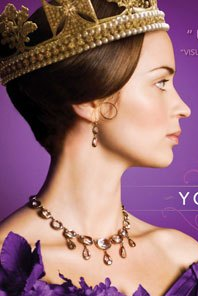 |
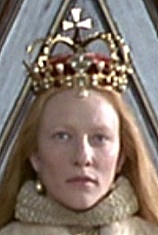 Elizabeth (1998) | The Virgin Queen (2005) | 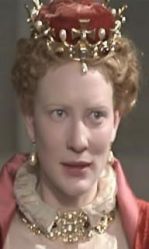 Elizabeth (1998) |
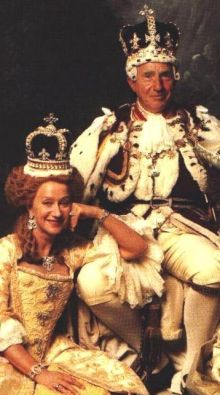 Hellen Mirren as Queen Charlotte | 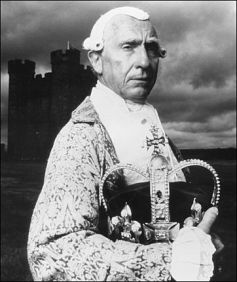 The Madness of George III (1994) 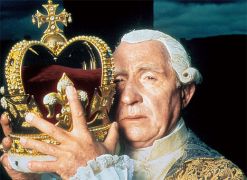 | 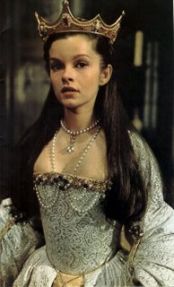 Anne of a Thousand Days (1969) |
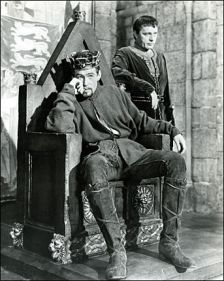 Becket (1964) Becket (1964) Peter O'Toole playing King Henry II | The actor Rowan Atkinson (alias Mister Bean) crowned King of England, 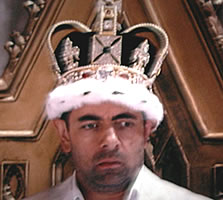 picture from the movie Johnny English, parody of James Bond. | 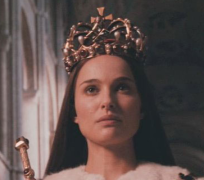 The Other Boleyn Girl |
